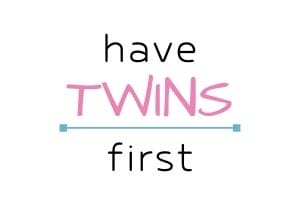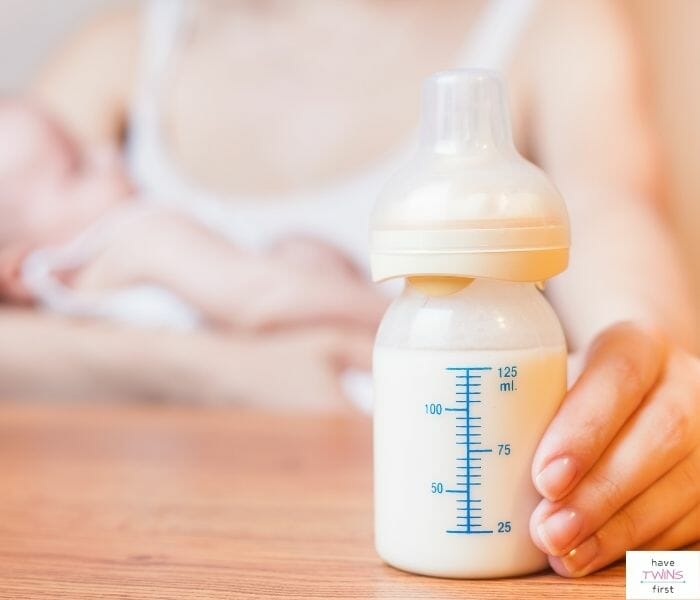Last updated: April 26, 2024
Whether you are exclusively pumping for your baby or looking to combine breastfeeding and pumping, it can be very difficult to figure out an ideal pumping schedule. As a mom who has exclusively pumped and combined nursing and pumping, I will use this post to share the best pumping schedules for these different scenarios. I will also be going over how to efficiently pump breast milk, how long to pump, and how much breast milk you should be pumping.
Please note, there are affiliate links in this post. Read my privacy & disclosure policy at the bottom of this page to learn more.
Exclusive Pumping Schedule For A Newborn
When your baby is a newborn, there really is no set schedule. It’s feeding on demand and it can be exhausting.
Your baby will typically be hungry every 2 hours. Plus, the time between feedings starts at the beginning of the feed. So, if a feed takes 30 minutes, that means in another 90 minutes you will probably be starting another feed.
The good news is you know this crazy schedule is temporary. Here is an idea of what to expect for a newborn pumping schedule.
- Newborn: 8 pumps/day @ 6am, 8am, 10am, 1pm, 3pm, 6pm, 9pm, midnight
If you are struggling to pump enough milk, you can always add another pumping session or two or increase the length of time of your pumping session. Make sure you stay hydrated and are eating enough healthy foods too. And if that’s still not helping, then I highly recommend taking the Exclusive Pumping class from Milkology to get yourself on track.
Finally, if you would like a FREE printable version of a sample newborn exclusive pumping schedule (plus some bonus schedules) just click the button below!
Exclusive Pumping Schedule Examples
As your baby gets older the schedule will become more dependable. The time between feedings will increase and the length of each feed will decrease. In other words, it slowly gets easier! Take a look at the lists below for example pumping schedules through the first year of your baby’s life.
- 3 to 6 months: 6 pumps/day @ 6am, 9am, noon, 3pm, 7pm, 11pm
- 6 to 10 months: 5 pumps/day @ 8am, 11am, 2pm, 5pm, 11pm
- 10+ months: 4 pumps/day @ 8am, noon, 4pm, 11pm
These are meant to be example schedules that give you an idea of what to expect when exclusively pumping for your baby. As your baby gets older, especially past 6 months (when your baby starts solids), the number of required pumping sessions could be less than listed here.
I definitely recommend you modify the pumping times listed to fit your needs. Pump the number of times listed per day with approximately the same time in between pumps. Just modify the times you pump at, as needed for your schedule.
Pumping Schedule For Combined Nursing And Pumping
If you are doing a combined nursing and pumping schedule, it can seem complicated. A typical situation where this arises is for working moms.
A general rule of thumb for pumping at work schedules, is to pump for any feed you miss while you are away from your baby. However, I will say from personal experience, that I only pumped twice a day at work. Meanwhile, my baby would eat three times while I was working.
Quite often 2 pumps per day was enough breast milk for my baby. Pumping more than twice a day at work was going to be difficult, so this is what I committed to. I knew I might have to supplement with formula, but I was pleasantly surprised that it was a very small amount of formula. And some days, my baby didn’t need any formula at all.
For more details on sample combined nursing and pumping schedules, you can check out these posts:
If you need some extra help as a working and pumping mom, then I highly recommend the Back To Work Pumping class from Milkology. I found returning to work while pumping stressful, and this class will help take away some of that stress.

How To Pump Breast Milk
As a pumping mom it’s vital to understand how to pump breast milk. This article is not intended to delve into the basics of pumping breast milk. So I recommend you check out the following document with an overview of how to use a breast pump.
How Long Should You Pump Per Session?
If you have a double electric breast pump (which I highly recommend for maximum efficiency), then your pumping sessions will typically last anywhere from 12 to 17 minutes. The actual pumping will be 10 to 15 minutes with 1 minute for setup and 1 minute for clean up.
How Often Should You Pump?
At least initially, you will need to pump for every feed that your newborn baby has. This will help build and maintain your milk supply. Going beyond the newborn phase, the general rule will remain the same. Pump every time your baby eats.
However, once you have an established milk supply, if you miss pumping once or twice a week, it probably won’t make a big difference. I know personally I was always so nervous about skipping a pumping session, so I rarely did it. And don’t forget, if it just becomes too hard to keep up, then you can always supplement with formula.
How Much Milk Should I Be Pumping?
The amount of breast milk you should pump per session will vary by your baby’s age. Additionally, as the day goes on and your energy dwindles, your milk supply also goes down.
Your first pumping session of the day will almost always produce the greatest amount of breast milk. Check out the breast milk quantity chart by baby’s age below. This will give you an idea of how much breast milk you should be producing if you are exclusively pumping.
Keep in mind, if you pump a lot in the morning, then you might use some of this milk for more than one feeding during the day. This will help make up for a smaller milk supply later in the day.
Baby's Age | Feedings per Day | Breast Milk / Day (oz) | Average Oz per Feed |
0-3 months | 8 | 24 - 30 | 2 - 3 |
3-6 months | 6 | 24 - 30 | 4 - 5 |
6-10 months | 5 - 6 | 24 - 30 | 4 - 6 |
If you are having difficulty producing enough breast milk, then you should try increasing the number of pumping sessions to keep up with your baby’s appetite. Do keep in mind that another culprit could be worn out pump parts.
The ones you have to change most often are the membranes, make sure you change them every few weeks. For more milk supply tips, check out this article to find out what to do when you are not pumping enough milk.
On top of that, if you really want to nail down any milk supply problems, then Milkology has you covered. Check out the Pump It Up online class. This class is designed specifically to solve milk supply issues for pumping moms. It is super affordable, making it totally worth the small price tag.
What Gear Do You Need For Pumping?
It’s vital to have the right pumping gear to be successful. Be sure you have the following pumping items.
- Breast Pump – Medela was my personal favorite
- Bottles – I recommend getting ones that are compatible with your pump. For example, I used Medela bottles because I had a Medela pump.
- Breast Milk Storage Bags – Lansinoh are my favorite
- Hands Free Pumping Bra – the Simple Wishes bra was excellent
- Burp Cloths – I recommend flannel ones
- Breast Pads – pick between disposable, reusable, or both
- Lanolin – I liked Medela’s lanolin best
- Nursing Bras – Target has a great selection
You will also want to find a spot with a chair that has good back support. No slouching while you pump, it will reduce the amount of milk you produce. I also always had something with me like a book, phone, or tablet because pumping sessions can get pretty repetitive and boring.
How To Store Breast Milk
If you will not be feeding your pumped breast milk within 4 hours, then it will need to be refrigerated. I kept my pumped breast milk for fridge storage in bottles.
Breast milk lasts for 4 days in the fridge and after that, it needs to be frozen. When it was time to freeze breast milk, I would pour it in a breast milk storage bag. Don’t forget to fill out the label with the date when freezing your breast milk.
>>Hang these Breast Milk Storage Guidelines on your fridge for quick reference!<<
Make sure you get your pumping schedule right and set yourself up for pumping success!
I hope this post has helped answer some questions about typical pumping schedules. Before I sign off, I also want to share these printable Pumping Schedules & Logs with you.
It includes everything you need to stay organized as a pumping mom including sample pumping schedules, logs for breast milk output, breast milk inventory, and pump part inventory, breast milk storage guidelines, a pumping privacy sign, and a daily baby feeding and diaper log.
Good luck on your pumping adventures mama, you’ve got this! And don’t forget to grab your FREE printable newborn exclusive pumping schedule + blank schedule before you go too.







